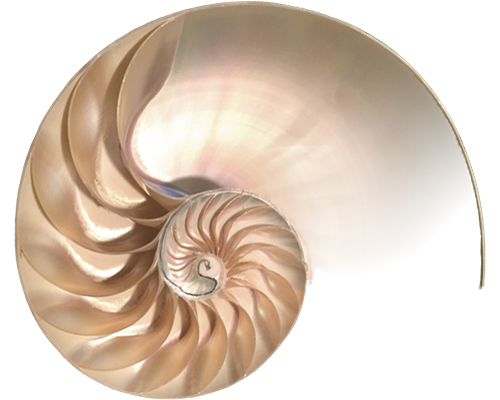Soulscape
The Assarian Cancer Center's Reflection Space is the centerpiece of a three-part healing arts center based on a right brain - left brain - soul brain model. The notion that each individual needs very different things to come to peace on their cancer journey is reflected in the very architecture of the building.
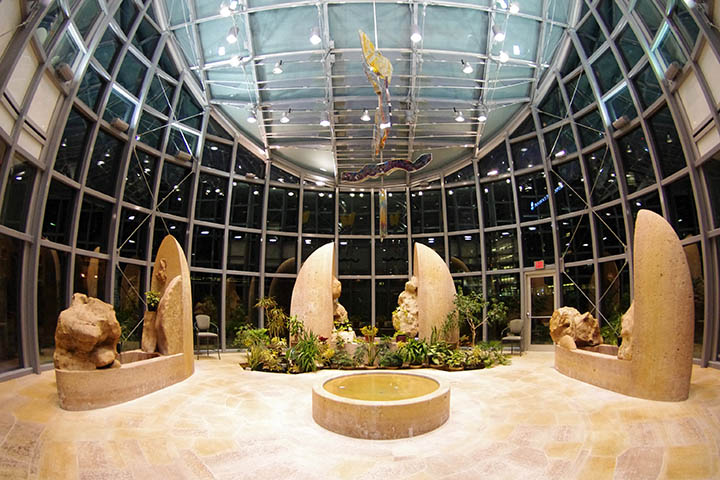
The fundamental infrastructure of the soul is initiation or the initiation cycle. The soul must leave its home and comfort, come to an unfamiliar and fearful place, and then return, transformed. Illness may be seen as an initiation.
Fundamental psychological events occur at each point in the cycle. The first station is loss, specifically loss of the good or positive. Loss of what is loved brings the pain of grief. The loss of the positive brings a profound suffering, but it is not the same as experiencing the purely negative.
That said, if you have known anyone who has lost a beloved pet and finds life without that pet unbearable, it is hard to be dismissive of loss as a lesser form of suffering. In the Bible, Job suffers the loss of everything good in his life and endures graciously. The greater test follows. He is afflicted with physical misery, the direct experience of the negative.
To be afflicted with pain, with suffering from an illness, with hopelessness, is another station in the cycle. To be trapped there is the essence of despair. Yet this despair or bottoming out triggers a profound defiance, a decision to move through the suffering, sustained by the hope of deliverance.
The next step is release from the negative, or deliverance. Simple removal of the negative can bring ecstatic joy and celebration. People suffering from pain or despair do not dream of the good things in life; they dream of being delivered from their suffering as the very best thing possible.
Yet deliverance from suffering is not full recovery of the positive. One cannot abide for long in the desert. One must reach a land to call home. Having experienced this great disruption and suffering, one is now fully conscious and fully aware of the treacherous possibilities hidden by good fortune until then.
Wendell Heers, the lead artist for the reflection space, depicted the key stations of the initiation cycle with sculptural forms that transform shape, as if the sculpture itself is undergoing initiation. Most importantly, he depicted the fundamental structure of being as a dyad, a dialogue or interplay between self and soul, self and other, disrupted in order to transform and mature the soul.
“Love is what you get through together,” is how the great American humorist James Thurber put this. The individual struggle may make a hero of you, but getting through this with another is how another kind of greatness is reached. In the cancer clinic, there is almost always a “corner team” sharing the struggle with the individual patient.
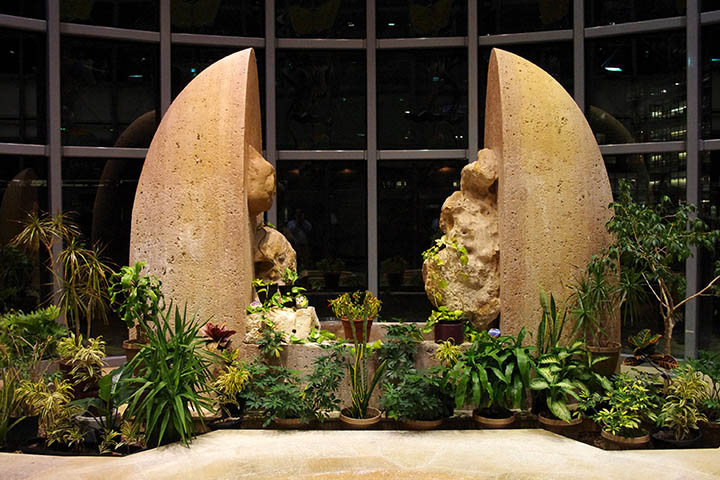
The positive pole is marked by symmetric forms, communing in a central pool, surrounded by a rich garden.
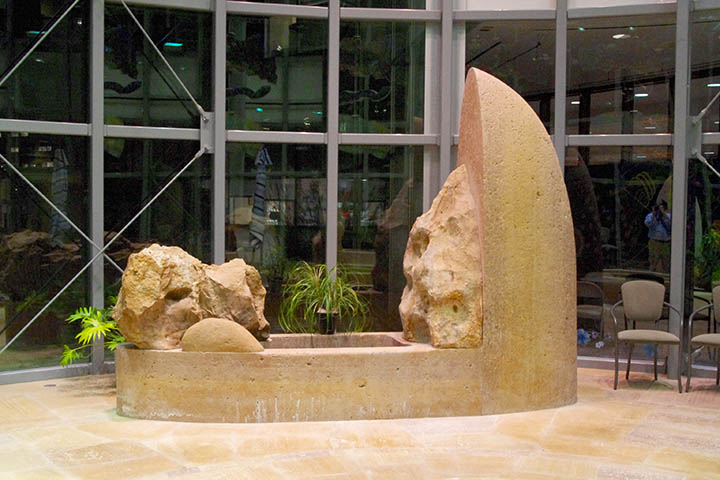
The loss of the positive is marked by an asymmetric form, and a slowly trickling fountain of tears. One has lost something, and the pain of grief ensues.

The negative pole is marked by a flat stone. All communing is lost. Grief is terrible because the part of you that lived with and through another must ultimately die as well. The soul is fully exposed on a bed of stone. In the biblical tale Jacob rests his head on a pillow of stone in the wilderness of his dark night of the soul.
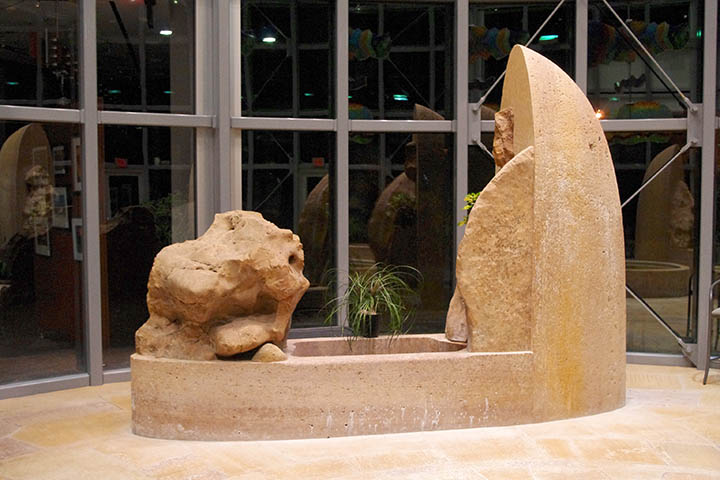
The deliverance stone form is again asymmetric but represents escape from suffering and the return to life. Water flows from the rock, as it flowed form the rock Moses struck in the desert. Released from suffering the soul appreciates life in a way it never had before.
Finally, the soul returns to wholeness and the blissful communion with life is restored, but the person is transformed, has matured, and will never be the same.
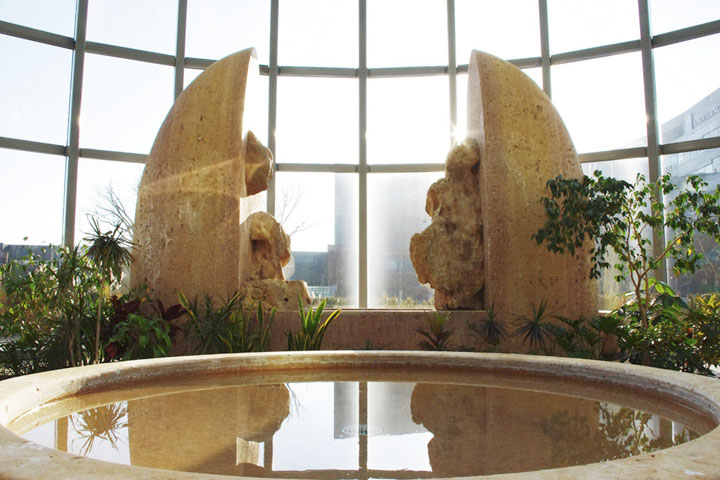
That wheel of fortune and misfortune, the agony and ecstasy cycle of initiation is at the heart of western spirituality. Countering this cycle in the Reflection Space is the pool of calm at the center, the essence of eastern spirituality. No matter how violently the storm of life rages, finding a calm place of composure remains possible. This concept is not familiar to many, but is a very welcome possibility for a patient facing the ordeal of cancer.
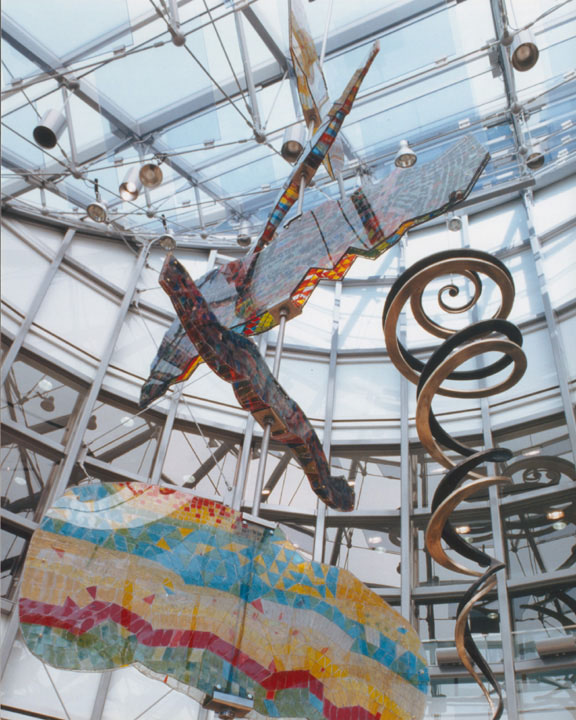
Above the pool hangs a glass sculpture by Jerry Kamrowski. This piece combines eastern and western traditions. In the eastern tradition the soul is a stone that must be polished to perfection by experience. The lowest panel represents the soul in exile. The linear form above the lower panel represents the Red Sea through which the souls must pass for deliverance. The central panel represents the desert – the soul escapes the negative of exile but wanders lost and without direction. The next linear form is the Jordan River, the final barrier to the “land of milk and honey.” Each panel in the hanging sculpture represents the soul’s experience of each domain – exile, desert, and paradise. The soul’s beauty and greatness is directly related to the depth and breadth of its experience.
A dramatic double helix sculpture by Scott Lankton also hangs above and represents an abstract image of the biblical story of Jacob’s ladder. In his moment of extreme desolation in the wilderness, Jacob rested his head on a pillow of stone and experienced a vision of angels rising up to heaven and descending from heaven. The angels brought an unexpected consolation and hope. This represents the universal human experience of suffering, in which the soul moves from self-pity and despair to empowerment, as a strength one scarcely knew was possible is revealed.
On the floor of the Reflection Space are writings from many spiritual traditions that articulate the feelings of the soul at that point in the initiation cycle. The sources of the writings are not identified to allow an unbiased meditation. One writing bears special attention. It is a poem, In Passing, by a patient presented in a stapled journal of poems for a local exhibit of art and writings by cancer patients. The author introduces the poem:
"I am grateful to have had cancer. Since my illness, each day is unrealized until I have given to it all that I can and extracted from it through deliberate, thoughtful living, the lesson of that day. From this I have learned that loving is really all that matters."
"As the days go by, I acknowledge that I am not afraid to die. The work, In Passing, represents the process through which I came to that knowledge. I have served the purpose of human life. In the days that remain to me, no matter how many their number, it is my intention to live well – to be honest with myself, to be a fully integrated human being, to live well and to be well loved."
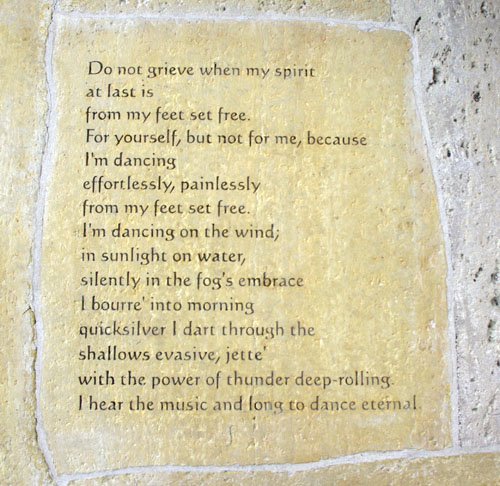
In Passing
Do not grieve when my spirit at last is
From my feet set free.
For yourself, but not for me,
Because I’m dancing effortlessly,
Painlessly from my feet set free.
I’m dancing on the wind;
In sunlight on water,
Silently in the fog’s embrace
I bound into morning.
Quicksilver, I dart through the shallows evasive,
Jette’ with the power of thunder deep-rolling.
I hear the music and long to dance eternal.
-Cynthia Kuhn
